Design and Characterization of Wideband Terahertz Metamaterial Stop-Band Filter
Abstract
:1. Introduction
2. Design and Simulation
3. Analysis and Discussion
3.1. Filter Optimization
3.2. Filter Performance Analysis
3.3. Analysis of Filter Mechanism
4. Conclusions
Author Contributions
Funding
Conflicts of Interest
References
- Smith, D.R.; Padilla, W.J.; Vier, D.C.; Nemat-Nasser, S.C.; Schultz, S. Composite Medium with Simultaneously Negative Permeability and Permittivity. Phys. Rev. Lett. 2000, 84, 4184–4187. [Google Scholar] [CrossRef] [PubMed] [Green Version]
- Shelby, R.A.; Smith, D.R.; Schultz, S. Experimental Verification of a Negative Index of Refraction. Science 2001, 292, 77–79. [Google Scholar] [CrossRef] [PubMed] [Green Version]
- Pendry, J.B. Negative Refraction Makes a Perfect Lens. Phys. Rev. Lett. 2000, 85, 3966–3969. [Google Scholar] [CrossRef] [PubMed]
- Pendry, J.B.; Schurig, D.; Smith, D.R. Controlling Electromagnetic Fields. Science 2006, 312, 1780–1782. [Google Scholar] [CrossRef] [PubMed] [Green Version]
- Schurig, D.; Mock, J.J.; Justice, B.J.; Cummer, S.A.; Pendry, J.B.; Starr, A.F.; Smith, D.R. Metamaterial Electromagnetic Cloak at Microwave Frequencies. Science 2006, 314, 977–980. [Google Scholar] [CrossRef] [Green Version]
- Zheludev Nikolay, I. The Road Ahead for Metamaterials. Science 2010, 328, 582–583. [Google Scholar] [CrossRef] [PubMed]
- Zhao, Q.; Du, B.; Kang, L.; Zhao, H.; Xie, Q.; Li, B.; Zhang, X.; Zhou, J.; Li, L.; Meng, Y. Tunable negative permeability in an isotropic dielectric composite. Appl. Phys. Lett. 2008, 92, 051106. [Google Scholar] [CrossRef]
- Yi, L.; Nishida, Y.; Sagisaka, T.; Kaname, R.; Mizuno, R.; Fujita, M.; Nagatsuma, T. Towards Practical Terahertz Imaging System with Compact Continuous Wave Transceiver. J. Lightwave Technol. 2021, 39, 7850–7861. [Google Scholar] [CrossRef]
- Nagatsuma, T. Terahertz technologies: Present and future. IEICE Electron. Express 2011, 8, 1127–1142. [Google Scholar] [CrossRef] [Green Version]
- Yen, T.J.; Padilla, W.J.; Fang, N.; Vier, D.C.; Smith, D.R.; Pendry, J.B.; Basov, D.N.; Zhang, X. Terahertz Magnetic Response from Artificial Materials. Science 2004, 303, 1494–1496. [Google Scholar] [CrossRef] [Green Version]
- Al-Gburi, A.; Ibrahim, I.; Zakaria, Z.; Subhi Ahmad, K.; Zeain, M.; Abdulhameed, M.; Saeidi, T. A miniaturised UWB FSS with Stop-band Characteristics for EM Shielding Applications. Prz. Elektrotechniczny 2021, 25, 142–145. [Google Scholar] [CrossRef]
- Dong, J.; Ma, Y.; Li, Z.; Mo, J. A Miniaturized Quad-Stopband Frequency Selective Surface with Convoluted and Interdigitated Stripe Based on Equivalent Circuit Model Analysis. Micromachines 2021, 12, 1027. [Google Scholar] [CrossRef]
- Han, N.R.; Chen, Z.C.; Lim, C.S.; Ng, B.; Hong, M.H. Broadband multi-layer terahertz metamaterials fabrication and characterization on flexible substrates. Opt. Express 2011, 19, 6990–6998. [Google Scholar] [CrossRef]
- Li, Z.; Ding, Y.J. Terahertz Broadband-Stop Filters. IEEE J. Sel. Top. Quantum Electron. 2013, 19, 8500705. [Google Scholar]
- Ruan, J.; Lan, F.; Wang, L.; Ji, S. Ultra-wideband THz metamaterial filter with steep cut-off. J. Electromagn. Waves Appl. 2021, 35, 431–440. [Google Scholar] [CrossRef]
- Junlin, W.; Binzhen, Z.; Xin, W.; Junping, D. Flexible dual-band band-stop metamaterials filter for the terahertz region. Opt. Mater. Express 2017, 7, 1656–1665. [Google Scholar] [CrossRef]
- Choi, M.; Kang, B.; Yi, Y.; Lee, S.H.; Kim, I.; Han, J.-H.; Yi, M.; Ahn, J.; Choi, C.-G. Terahertz transmission resonances in complementary multilayered metamaterial with deep subwavelength interlayer spacing. Appl. Phys. Lett. 2016, 108, 201103. [Google Scholar] [CrossRef]
- Li, X.; Yang, L.; Hu, C.; Luo, X.; Hong, M. Tunable bandwidth of band-stop filter by metamaterial cell coupling in optical frequency. Opt. Express 2011, 19, 5283–5289. [Google Scholar] [CrossRef]
- Berthier, S.; Lafait, J. Effective medium theory: Mathematical determination of the physical solution for the dielectric constant. Opt. Commun. 1980, 33, 303–306. [Google Scholar] [CrossRef]
- Li, L.; Wang, J.; Ma, H.; Wang, J.; Feng, M.; Du, H.; Yan, M.; Zhang, J.; Qu, S.; Xu, Z. Achieving all-dielectric metamaterial band-pass frequency selective surface via high-permittivity ceramics. Appl. Phys. Lett. 2016, 108, 122902. [Google Scholar] [CrossRef]
- Zhong, M. Localized surface plasmon resonnance induced terahertz broad absorption band. Opt. Commun. 2015, 356, 607–611. [Google Scholar] [CrossRef]
- Ebrahimi, A.; Nirantar, S.; Withayachumnankul, W.; Bhaskaran, M.; Sriram, S.; Al-Sarawi, S.F.; Abbott, D. Second-Order Terahertz Bandpass Frequency Selective Surface with Miniaturized Elements. IEEE Trans. Terahertz Sci. Technol. 2015, 5, 761–769. [Google Scholar] [CrossRef]
- Tan, C.; Wang, Y.; Yan, Z.; Nie, X.; He, Y.; Chen, W. Superconducting Filter Based on Split-Ring Resonator Structures. IEEE Trans. Appl. Supercond. 2019, 29, 4. [Google Scholar] [CrossRef]
- Liu, Z.; Qi, L.; Shah, S.M.; Sun, D.; Li, B. Design of Broad Stopband Filters Based on Multilayer Electromagnetically Induced Transparency Metamaterial Structures. Materials 2019, 12, 841. [Google Scholar] [CrossRef] [Green Version]
- Junlin, W.; Xin, W.; Ding, H. Terahertz wide stop-band metamaterials filter based on metal-dielectricmetal structure. J. Infrared Millim. Waves. 2019, 38, 722–727. [Google Scholar]
- Asl, A.B.; Rostami, A.; Amiri, I.S. Terahertz band pass filter design using multilayer metamaterials. Opt. Quantum Electron. 2020, 52, 155. [Google Scholar] [CrossRef]
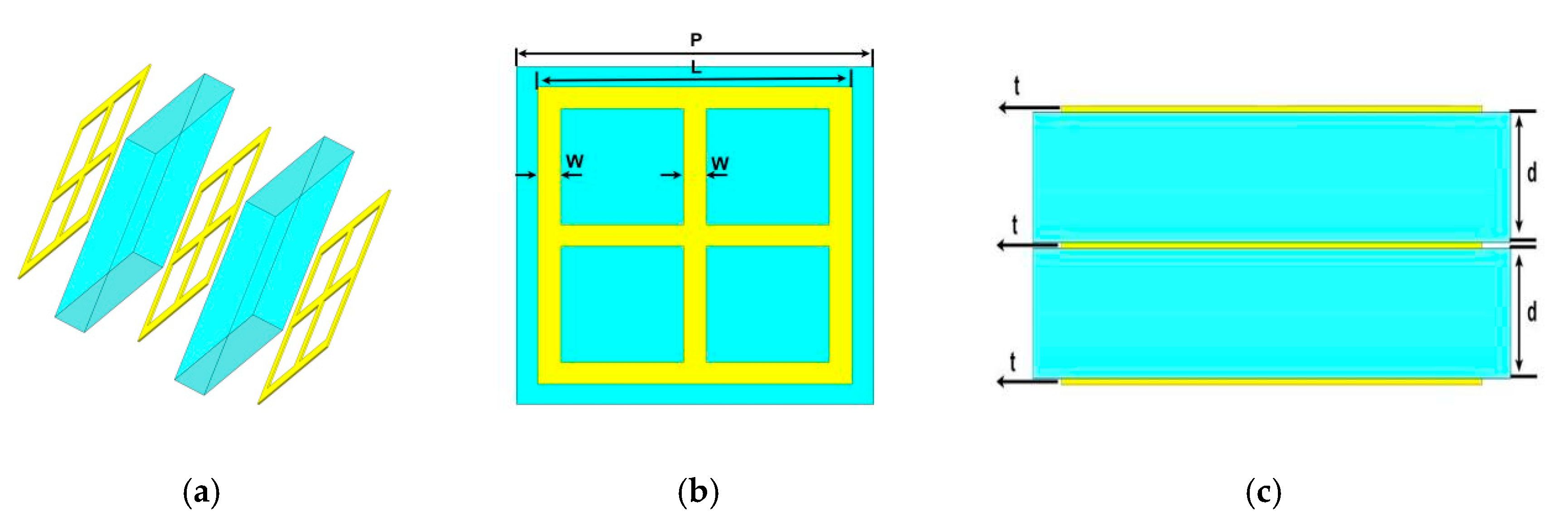

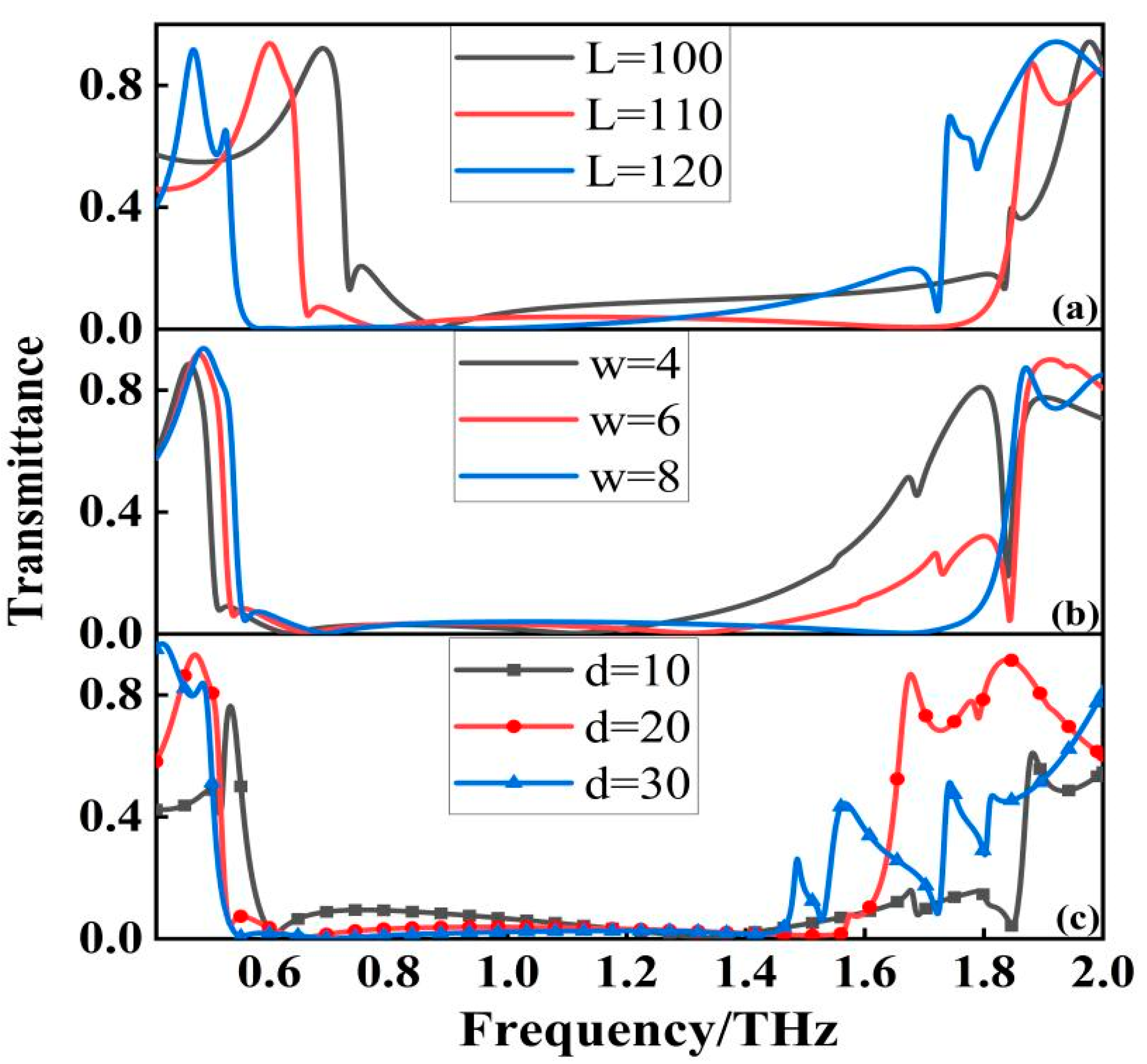

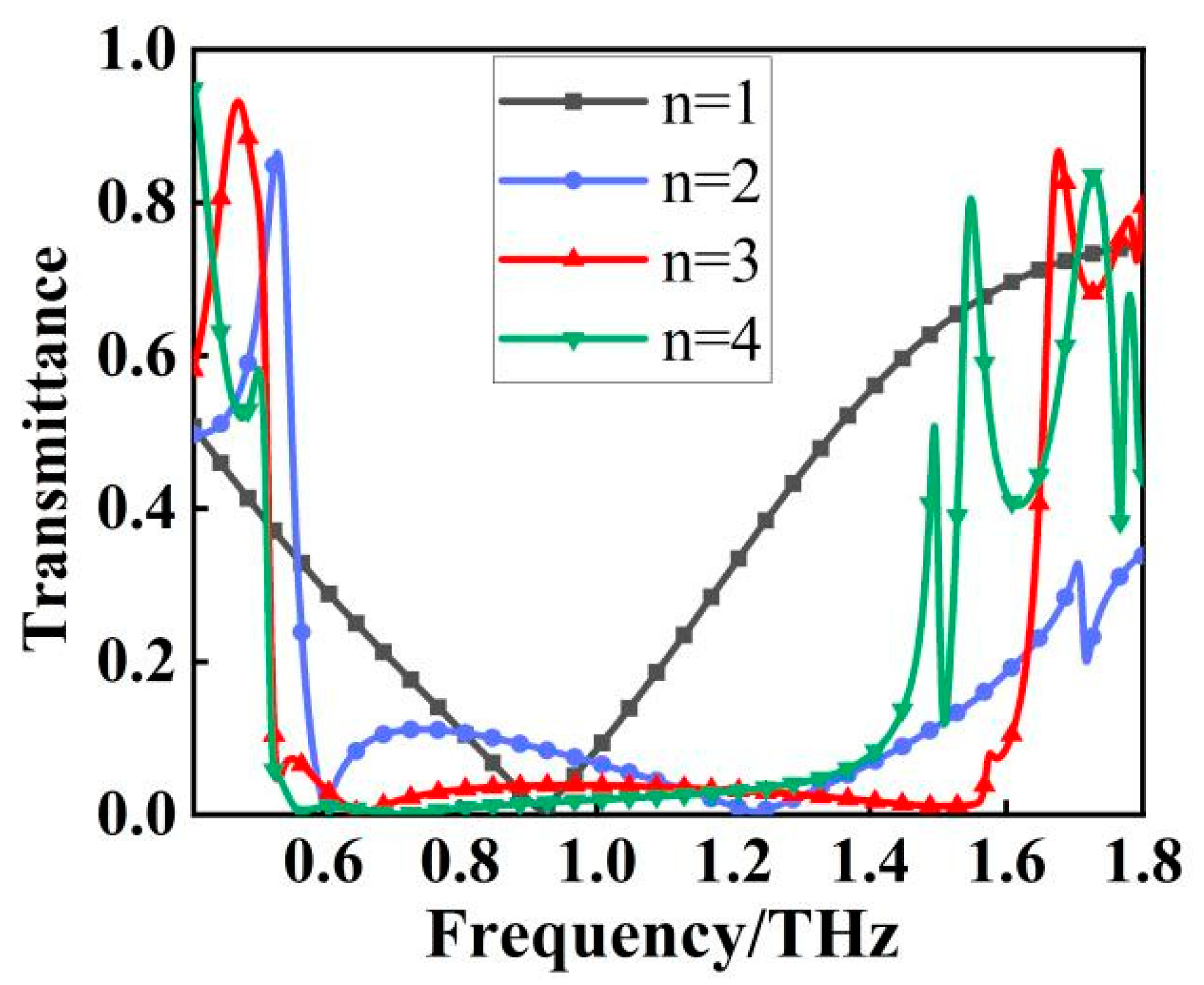
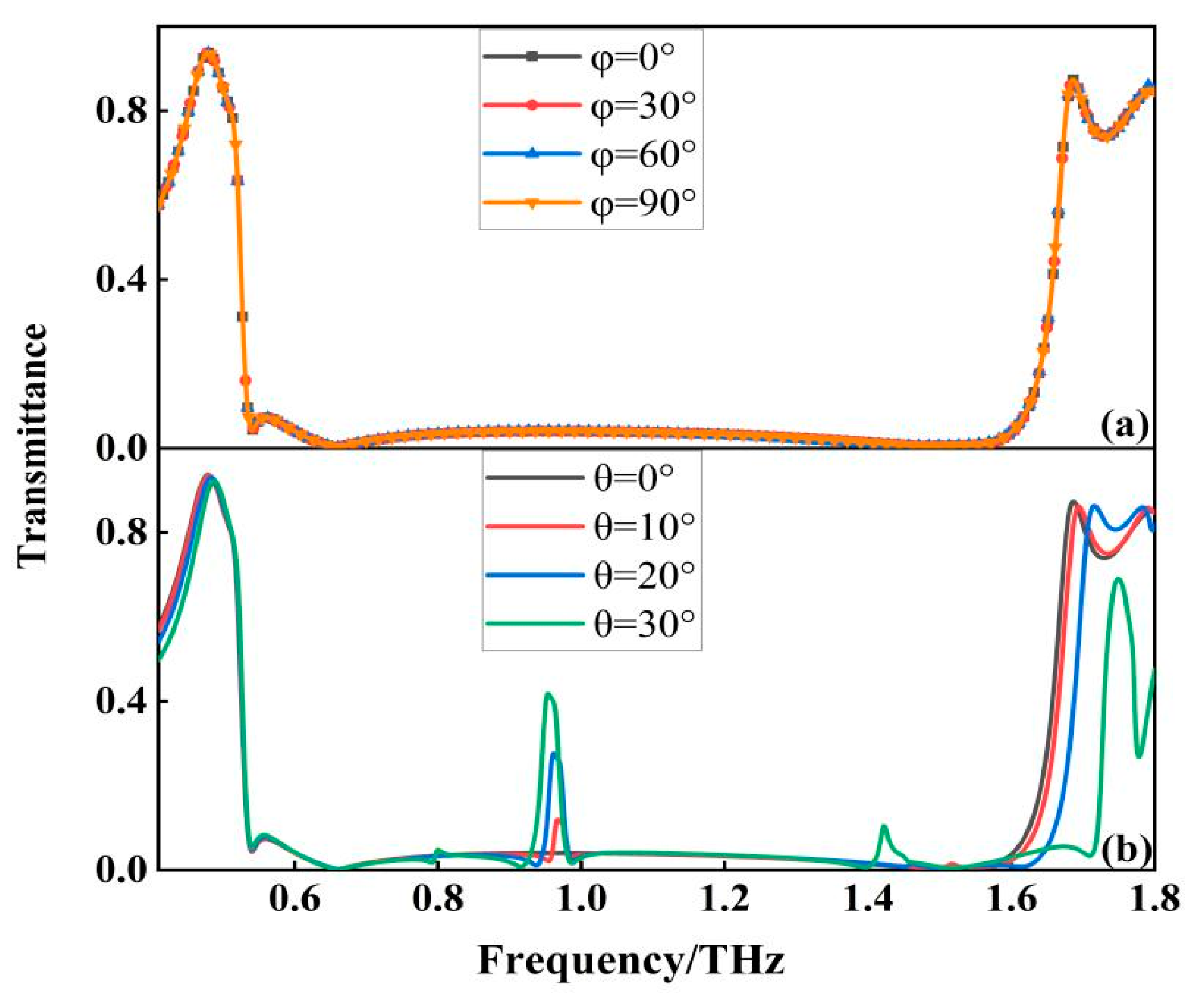
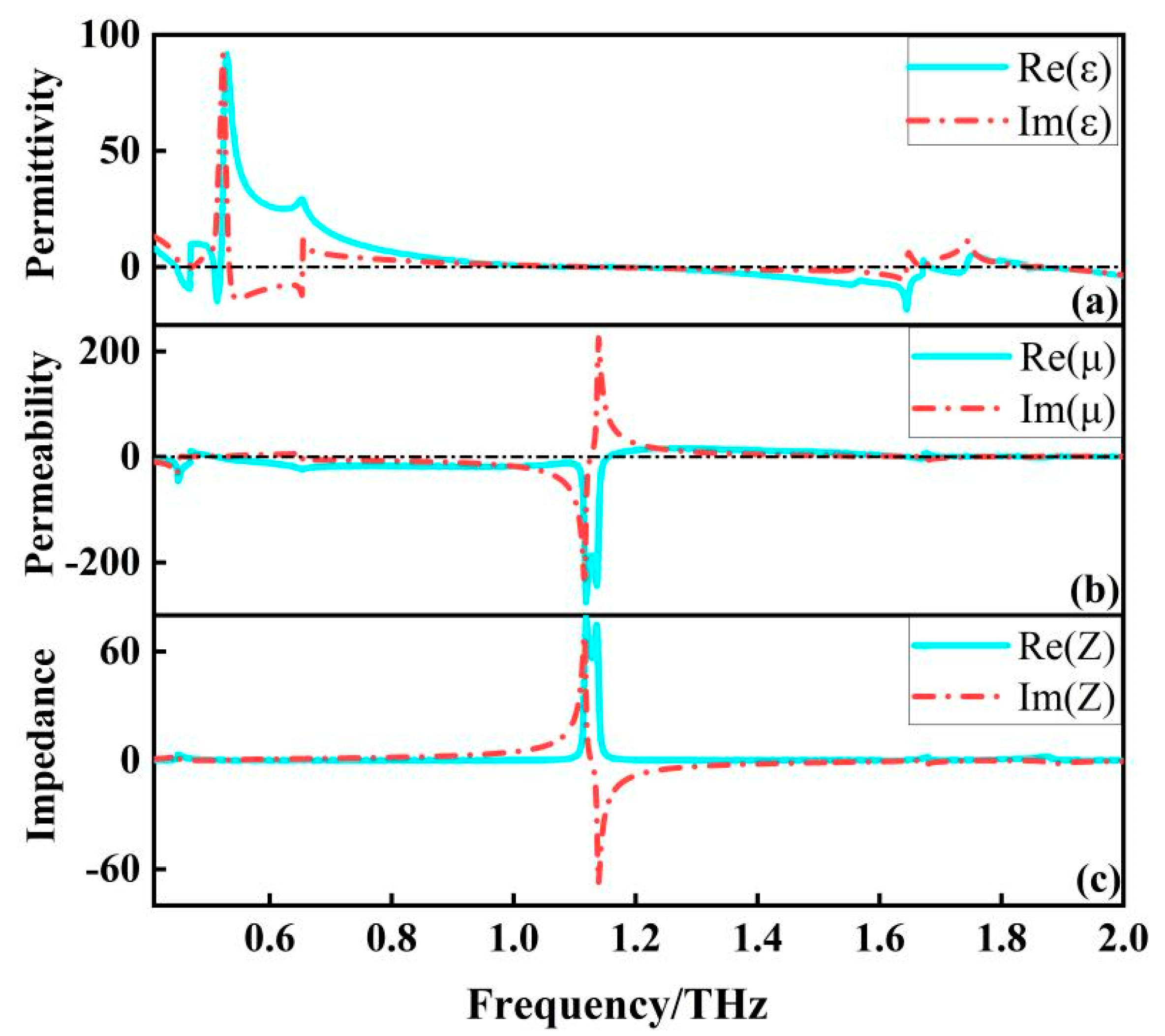
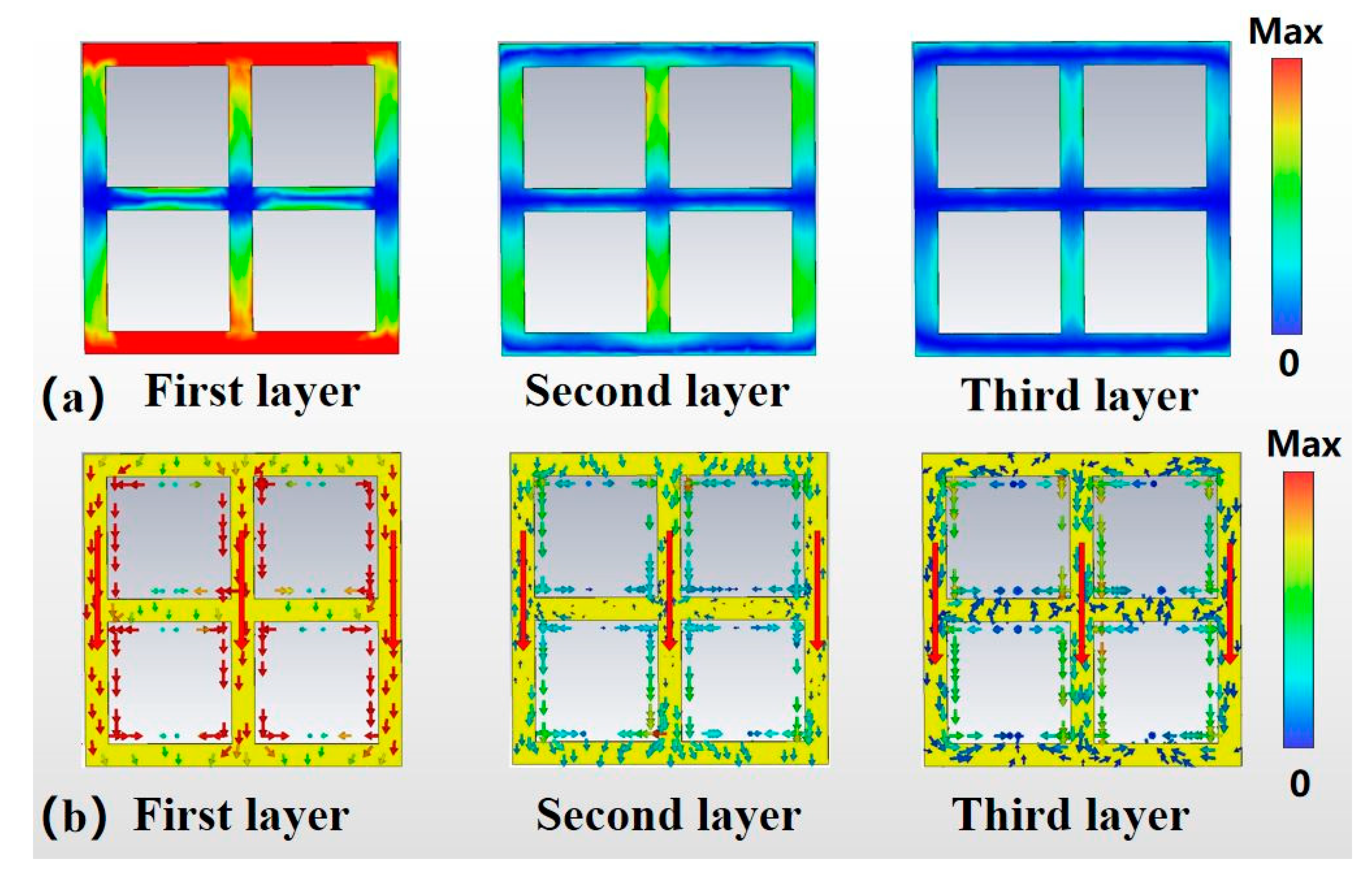
| Ref. | Cell Dimension | Square Ratio | In-Band Transmittance | Relative Bandwidth |
|---|---|---|---|---|
| [9] | 1 mm·1 mm | 0.92 | >5% | 65% |
| [22] | 130 μm·130 μm | 0.44 | >10% | 43% |
| [23] | 6.6 mm·6.6 mm | 0.82 | >5% | 2.14% |
| [24] | 0.4 μm·0.4 μm | 0.8 | >20% | 40% |
| [25] | 0.7 mm·0.7 mm | 0.6 | >5% | 58% |
| [26] | 140 μm·140 μm | 0.56 | >20% | 76% |
| This work | 125 μm·125 μm | 0.95 | >4% | 99% |
Publisher’s Note: MDPI stays neutral with regard to jurisdictional claims in published maps and institutional affiliations. |
© 2022 by the authors. Licensee MDPI, Basel, Switzerland. This article is an open access article distributed under the terms and conditions of the Creative Commons Attribution (CC BY) license (https://creativecommons.org/licenses/by/4.0/).
Share and Cite
Li, H.; Wang, J.; Wang, X.; Feng, Y.; Sun, Z. Design and Characterization of Wideband Terahertz Metamaterial Stop-Band Filter. Micromachines 2022, 13, 1034. https://doi.org/10.3390/mi13071034
Li H, Wang J, Wang X, Feng Y, Sun Z. Design and Characterization of Wideband Terahertz Metamaterial Stop-Band Filter. Micromachines. 2022; 13(7):1034. https://doi.org/10.3390/mi13071034
Chicago/Turabian StyleLi, Hao, Junlin Wang, Xin Wang, Yao Feng, and Zhanshuo Sun. 2022. "Design and Characterization of Wideband Terahertz Metamaterial Stop-Band Filter" Micromachines 13, no. 7: 1034. https://doi.org/10.3390/mi13071034
APA StyleLi, H., Wang, J., Wang, X., Feng, Y., & Sun, Z. (2022). Design and Characterization of Wideband Terahertz Metamaterial Stop-Band Filter. Micromachines, 13(7), 1034. https://doi.org/10.3390/mi13071034






